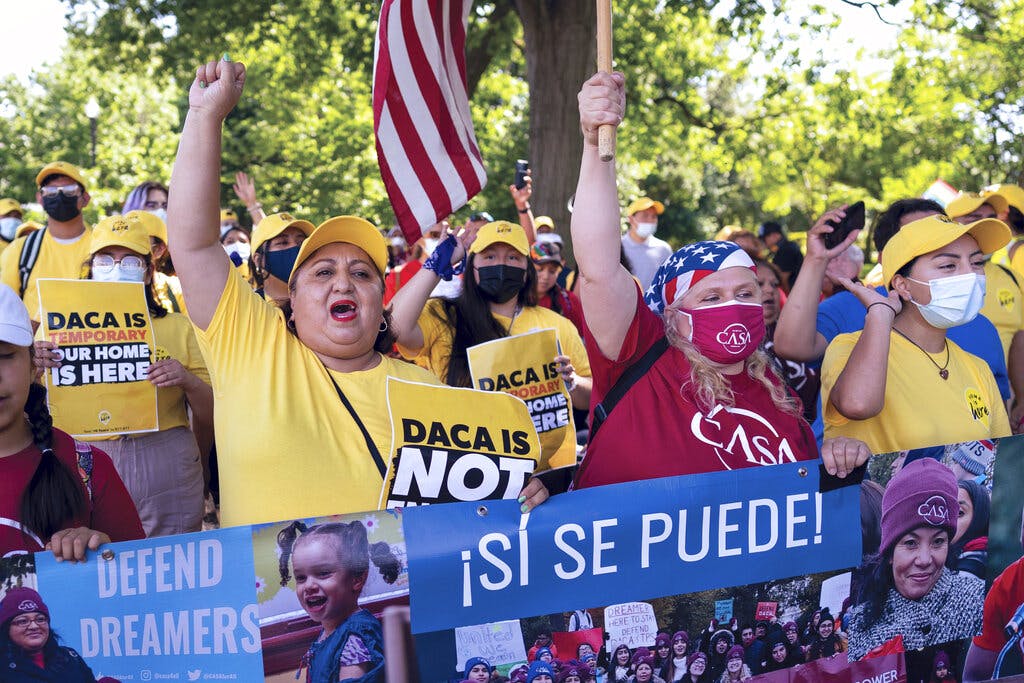Why New Americans Could — But Probably Won’t — Swing the Midterm Elections
The number of new Americans is greater than the margin of victory in the 2020 election in Arizona, Florida, Georgia, Nevada, Pennsylvania and Wisconsin.

Newly naturalized citizens could decide the fate of the Senate this year, but they probably won’t.
The National Partnership for New Americans tracks the number of newly minted Americans across the country and has identified a few states where they could make a critical difference this year.
In North Carolina, there are 70,579 new voters eligible to vote in the 2022 election who were not eligible to vote in 2020. That’s nearly equal to President Trump’s margin of victory there in 2020, 74,481.
In Georgia the number of new citizens is 96,469,z compared to a 2021 runoff election margin of 93,272 votes. In Arizona, there are more new citizens from Mexico alone than the state’s thin election 2020 election margin of about 10,000 votes.
All in all, the National Partnership for New Americans identified Arizona, Florida, Georgia, Nevada, Pennsylvania and Wisconsin as states where the number of new Americans is greater than the margin of victory in the 2020 election.
If those states sound familiar, it’s probably because these states are some of the key battleground states in the competition for control of the Senate in 2022.
In Georgia and Wisconsin, the races are looking like a toss-up, meaning new citizens could easily be the deciding factor in a close race. In North Carolina and Nevada, new Americans breaking overwhelmingly for one candidate could easily overcome modest partisan advantages in those states.
This sort of surprise result, however, is not a likely outcome in these races for a couple of reasons.
First off, newly naturalized citizens are less likely to vote than other demographics. According to a study by the Census Bureau, newly naturalized citizens are only about half as likely to vote as native born citizens.
Considering the fact that only about two-thirds of those who are eligible to vote cast ballots in 2020 — a record breaking year for voter turnout — this suggests that the portion of new citizens who make it to the polls will be rather modest.
In one study conducted by the Public Policy Institute of California, they found that naturalized Americans reported being interested in politics about half as often as native born Americans, and only 54 percent of naturalized Americans percent were considered likely voters compared to 61 percent of native born Americans.
Beyond this, newly naturalized citizens come from a great variety of backgrounds and don’t tend to break cleanly for one party or another, according to an associate editor at Sabato’s Crystal Ball, Miles Coleman.
“Don’t automatically assume that they would be voting one way,” he tells the Sun. “That’s a sort of assumption that overshadowed the 2020 election that minorities were going to vote Democrats.”
The data supports him as well. A 2012 Pew survey on the topic, the most recent available, compared party affiliation among Hispanic voters based on their status as naturalized or native born citizens.
They concluded that naturalized voters tend to have less powerful partisan affiliation than native born voters. Their survey found that 64 percent of native born Hispanic voters identified with a party, whereas only 53 percent of naturalized Hispanic voters identified with one.
For contrast, they found that 12 percent of native born Hispanic voters didn’t identify with either party, whereas 20 percent of naturalized Hispanic voters felt the same way.
Though there is an outside chance that naturalized voters make up the key demographic to tip an election, this isn’t the most likely outcome because new Americans simply don’t vote as a bloc.
The portion of the electorate that is made up of new voters is growing, however. According to Census Bureau data, the number of newly eligible immigrant voters nearly doubled between 2000 and 2020, growing to 23.2 million from 12 million.
According to Pew Research data, this has translated into a roughly 50 percent increase in their share of the electorate. In 2000, immigrants made up about 6.2 percent of the electorate. In 2020 immigrants made up 9.8 percent.
Exactly how many new Americans will be eligible to vote in the election this November is hard to say because concrete numbers on the national scale are not yet available.
Based on the trajectory of the past two decades, however, it does seem likely that new Americans will continue to make up an increasingly large portion of the electorate.

